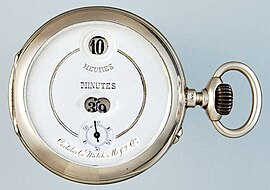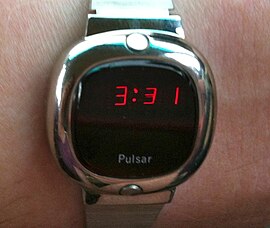Watch
A watch is a portable timepiece intended to be carried or worn by a person.[1] It is designed to keep a consistent movement despite the motions caused by the person's activities. A wristwatch is designed to be worn around the wrist,[2] attached by a watch strap or other type of bracelet, including metal bands, leather straps, or any other kind of bracelet. A pocket watch is designed for a person to carry in a pocket,[3] often attached to a chain.
For other uses, see Watch (disambiguation).
Watches appeared in the 16th century. During most of its history, the watch was a mechanical device, driven by clockwork, powered by winding a mainspring,[4] and keeping time with an oscillating balance wheel. These are called mechanical watches.[5][6] In the 1960s the electronic quartz watch was invented, which was powered by a battery and kept time with a vibrating quartz crystal. By the 1980s the quartz watch had taken over most of the market from the mechanical watch. Historically, this is called the quartz revolution (also known as the quartz crisis in Switzerland).[7][8] Developments in the 2010s include smart watches,[9] which are elaborate computer-like electronic devices designed to be worn on a wrist. They generally incorporate timekeeping functions, but these are only a small subset of the smartwatch's facilities.
In general, modern watches often display the day, date, month, and year. For mechanical watches, various extra features called "complications",[10] such as moon-phase displays and the different types of tourbillon, are sometimes included.[11] Most electronic quartz watches, on the other hand, include time-related features such as timers, chronographs, and alarm functions. Furthermore, some modern watches (like smart watches) even incorporate calculators, GPS[12] and Bluetooth technology or have heart-rate monitoring capabilities, and some of them use radio clock technology to regularly correct the time.
Most watches that are used mainly for timekeeping have quartz movements.[13] However, expensive collectible watches, valued more for their elaborate craftsmanship, aesthetic appeal, and glamorous design than for simple timekeeping, often have traditional mechanical movements, despite being less accurate and more expensive than their electronic counterparts.[7][8][14] As of 2018, the most expensive watch ever sold at auction was the Patek Philippe Henry Graves Supercomplication, the world's most complicated mechanical watch until 1989, fetching US$24 million (CHF 23,237,000) in Geneva on 11 November 2014.[15][16][17][18][19] As of December 2019, the most expensive watch ever sold at auction (and wristwatch) was the Patek Philippe Grandmaster Chime Ref. 6300A-010, fetching US$31.19 million (CHF 31,000,000) in Geneva on 9 November 2019.[20]
The movement and case are the basic parts of a watch. A watch band or bracelet is added to form a wristwatch; alternatively, a watch chain is added to form a pocket watch.[61]
The case is the outer covering of the watch.
The case back is the back portion of the watch's case. Accessing the movement (such as during battery replacement) depends on the type of case back, which are generally categorized into four types:
The crystal, also called the window or watch glass, is the transparent part of the case that allows viewing the hands and the dial of the movement.
Modern wristwatches almost always use one of 4 materials:[62]
The bezel is the ring holding the crystal in place.[65]
The lugs are small metal projections at both ends of the wristwatch case where the watch band attaches to the watch case.[65]
The case and the lugs are often machined from one solid piece of stainless steel.[66]
Speech synthesis[edit]
Talking watches are available, intended for the blind or visually impaired. They speak the time out loud at the press of a button. This has the disadvantage of disturbing others nearby or at least alerting the non-deaf that the wearer is checking the time. Tactile watches are preferred to avoid this awkwardness, but talking watches are preferred for those who are not confident in their ability to read a tactile watch reliably.
Handedness[edit]
Wristwatches with analog displays generally have a small knob, called the crown, that can be used to adjust the time and, in mechanical watches, wind the spring. Almost always, the crown is located on the right-hand side of the watch so it can be worn of the left wrist for a right-handed individual. This makes it inconvenient to use if the watch is being worn on the right wrist. Some manufacturers offer "left-hand drive", aka "destro", configured watches which move the crown to the left side[99] making wearing the watch easier for left-handed individuals.
A rarer configuration is the bullhead watch. Bullhead watches are generally, but not exclusively, chronographs. The configuration moves the crown and chronograph pushers to the top of the watch. Bullheads are commonly wristwatch chronographs that are intended to be used as stopwatches off the wrist. Examples are the Citizen Bullhead Change Timer[100] and the Omega Seamaster Bullhead.[101]
Digital watches generally have push-buttons that can be used to make adjustments. These are usually equally easy to use on either wrist.





